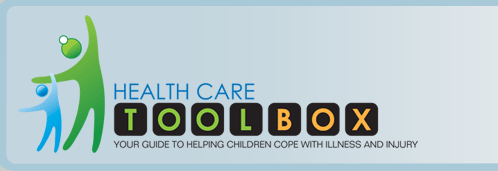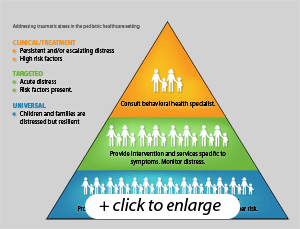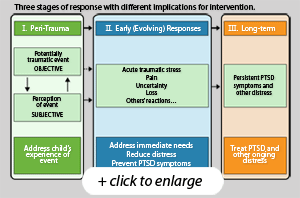Levels and Phases of Care: Multiple Opportunities for Intervention
Match the level of care to the child’s and family’s needs
It may be useful to think of preventing and treating traumatic stress reactions as a pyramid:
- CLINICAL/TREATMENT (at the top): A much smaller group of children and families need more extensive psychosocial support and evaluation or treatment by a mental health professional.
- TARGETED (in the middle): A few higher-risk or more distressed children and families need increased support and focused guidance to help them anticipate challenges and to strengthen their coping skills.
- UNIVERSAL (at the base): Most children and families need general information and support.
This preventive intervention model suggests that the health care team provide every ill or injured child and family with basic support and information and regularly screen for acute distress and risk factors to determine which children and families might need more support.
Respond appropriately in each phase of children's illness and injury experiences
The experience of an injury or illness unfolds in phases that can help pinpoint targets for prevention and intervention.
Phase I: Peri-trauma Providers caring for children as the initial events are still unfolding (in the midst of emergency care, giving a new and frightening diagnosis, carrying out procedures that may be painful or distressing) have the opportunity to reduce traumatic aspects of the experience for the child and family.
Phase II: Early (Evolving) Responses In the days and weeks that follow, the focus of intervention is addressing immediate emotional distress, promoting adaptive coping by the child and family (supporting existing strengths), and screening to determine who might need more support.
Phase III: Long-term Providers in many settings have the chance to care for children over the long haul – and can be instrumental in continuing to support adaptive coping, detecting persistent traumatic stress reactions or other emotional sequelae, and referring children and families for psychosocial assessment and treatment.





